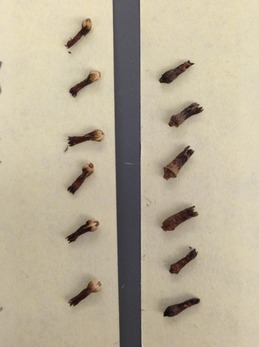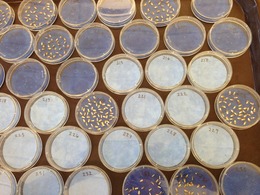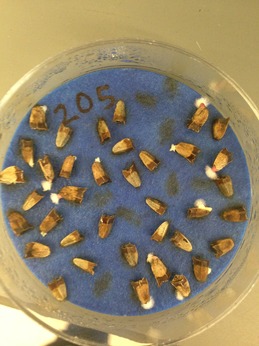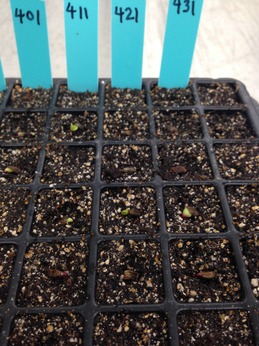|
|
While it may seem obvious, here at the Echinacea Project we look at a lot of Echinacea. With such large numbers–thousands of plants each summer and heads each winter– we’re used to a certain degree of variation. Bracts differ in length and degree of “pokey-ness”, trichome density varies among leaves, and achenes range in size and color (see the post “A Palette of Pallida” from March 21st for an example).
This morning one of our volunteers, Suzie, noticed that the florets on the head she was cleaning had a distinctly different shape and color. The florets come from CG-6152 wht, or plant 27, 915 in the quantitative genetics (qGen) section of the common garden. Below is is a side by side view of these unusual florets (on the left) compared with what we typically see.

This is the first time we’ve seen this sort of variation in floret shape and color in the lab. Right now we can’t say for certain what caused it, whether it’s natural variation or a response to insect herbivory, for example. It’ll be interesting to visit this plant next year, however, and see if this variation persists and is conspicuous when the plant is flowering.
Sarah Baker presented “Flowering phenology of Echinacea angustifolia in Minnesota tallgrass prairie remnants over three years,” the results of her summer 2013 REU project, at the National Conference on Undergraduate Research, University of Kentucky, on 4 April 2014.
Here’s the presentation…
Sarah_Baker_NCUR_Presentation_FINAL.pdf
It’s finally beginning to feel like spring here at the Chicago Botanic Garden and with the change in seasons, we’ve got some new projects in the lab.
All those E. pallida and E. angustifolia seeds I was weighing a couple weeks ago have been germinated and I’m in the process of transferring the sprouts to plug trays. The achenes first went through a two week cold-stratification, pre-germination treatment. I kept the achenes in petri dishes, evenly spread on blotter paper and put them in the refrigerator (4 degrees C), making sure to keep them well moistened throughout this time period.

After two weeks I transferred the achenes to the growth chamber where it was significantly warmer (25 degrees C) and put them close to the light.

Sprouts are ready once their radicle emerges 1 mm. Nearly 20% of the seeds germinated within 24 hours of being transferred to the growth chamber, and even more germinated the following day.

We place sprouts in plug trays were they’ll grow up for the next 5-7 weeks before being transplanted in the ground. And man oh man do they grow up fast! Can you spot the sprouts in this section of the plug tay?

|
|





